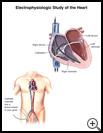
Electrophysiology Study of the Heart
________________________________________________________________________
KEY POINTS
- An electrophysiology study is a procedure done to find what is causing an abnormal heart rhythm.
- Ask your provider how long it will take to recover and how to take care of yourself at home.
- Make sure you know what symptoms or problems you should watch for and what to do if you have them.
________________________________________________________________________
What is an electrophysiology study?
An electrophysiology (EP) study is a procedure that may be done to find what is causing an abnormal heart rhythm.
An electrical signal in your heart starts each heartbeat, causing the heart muscle to squeeze (contract). Normally, this signal starts in the upper right chamber of the heart (the right atrium) at a place called the sinus node. The signal then follows pathways to the upper left atrium and to the lower chambers of the heart (the ventricles). You may have an abnormal heart rhythm if the electrical signals don’t follow the normal pathways or the nerve cells that make the electrical signals don’t work right.
An EP study uses small tubes called catheters inserted into a blood vessel and up into your heart to check the electrical signals and pathways in your heart. This test can find if the problem is where the electrical signal starts or if the problem is the pathway that the signal takes. It can help your provider find the right treatment for the problem.
When is it used?
An EP study may be done if your healthcare provider thinks there may be a problem with your heart rhythm. For example, your heart may beat faster or more slowly than normal, or it may skip beats or have abnormal beats.
An EP study can also test ways to treat an abnormal heart rhythm. Your provider may use this procedure to cause an abnormal rhythm and then try different medicines to see which medicines work best to bring your heart back to a normal rhythm.
How do I prepare for this procedure?
- If you are going home after the procedure, find someone to give you a ride.
- You may or may not need to take your regular medicines the day of the procedure. Tell your healthcare provider about all medicines and supplements that you take. Some products may increase your risk of side effects. Ask your healthcare provider if you need to avoid taking any medicine or supplements before the procedure.
- Tell your healthcare provider if you have any food, medicine, or other allergies such as latex.
- Your provider will tell you when to stop eating and drinking before the procedure. This helps to keep you from vomiting during the procedure.
- Follow any other instructions your healthcare provider gives you.
- Ask any questions you have before the procedure. You should understand what your healthcare provider is going to do. You have the right to make decisions about your healthcare and to give permission for any tests or procedures.
What happens during the procedure?
This procedure is usually done at the hospital.
You will be given medicine to keep you from feeling pain during the procedure. A local anesthetic will be given to numb the area where the wires will be inserted, along with medicine to help you relax.
Your healthcare provider will put 1 or more thin, flexible wires through a blood vessel in your groin or neck and into your heart. X-rays will be used to position the catheters in the right place. The wires will check the electrical impulses inside your heart. With the wires, your provider can find your heart's electrical pathways and check their condition. Your provider may use an electrical charge to start an abnormal heart rhythm and then test different medicines to see which medicines help prevent or stop the abnormal rhythm.
The procedure may last an hour or more.
What happens after the procedure?
After the procedure you may stay in an observation area for at least a few hours. Depending on your condition, you may need to stay in the hospital for 1 or more days.
You may have a bruise near the puncture site and be uncomfortable for a few days.
Follow your healthcare provider's instructions. Ask your healthcare provider:
- How and when you will get your test results
- How long it will take to recover
- If there are activities you should avoid and when you can return to your normal activities
- How to take care of yourself at home
- What kind of symptoms or problems you should watch for and what to do if you have them
Make sure you know when you should come back for a checkup. Keep all appointments for provider visits or tests.
What are the risks of this procedure?
Every procedure or treatment has risks. Some possible risks of this procedure include:
- You may have problems with anesthesia.
- You may have infection or bleeding.
- Blood clots may get into one or both of your child’s lungs.
- The wires might hurt the blood vessels or heart muscle or damage the heart’s electrical system.
- The wires might break during the procedure and need to be removed with surgery
- Blood clots may cause a heart attack or stroke.
- A heart rhythm problem that starts during the test may need treatment with an electric shock across the chest.
Ask your healthcare provider how these risks apply to you. Be sure to discuss any other questions or concerns that you may have.

